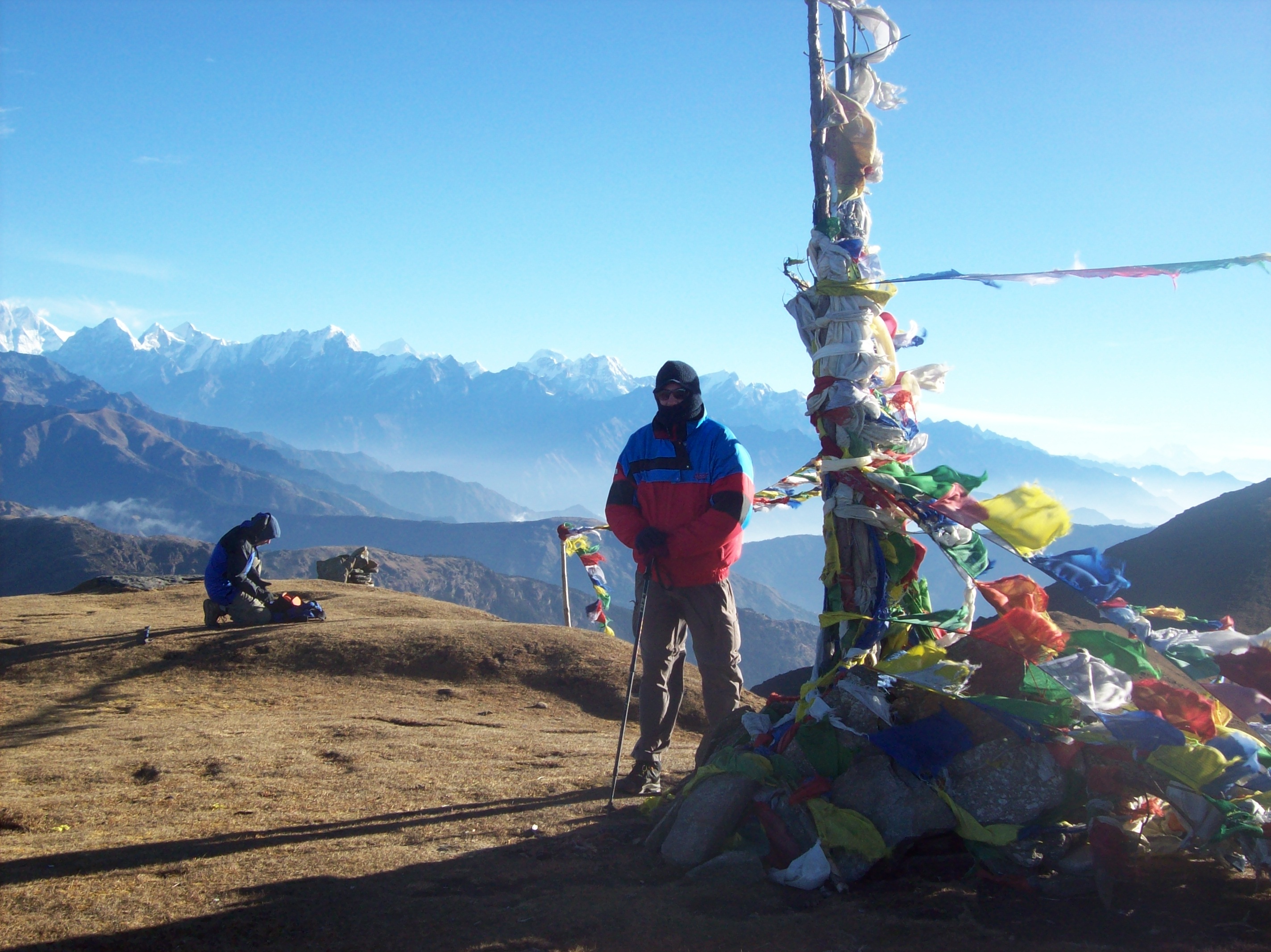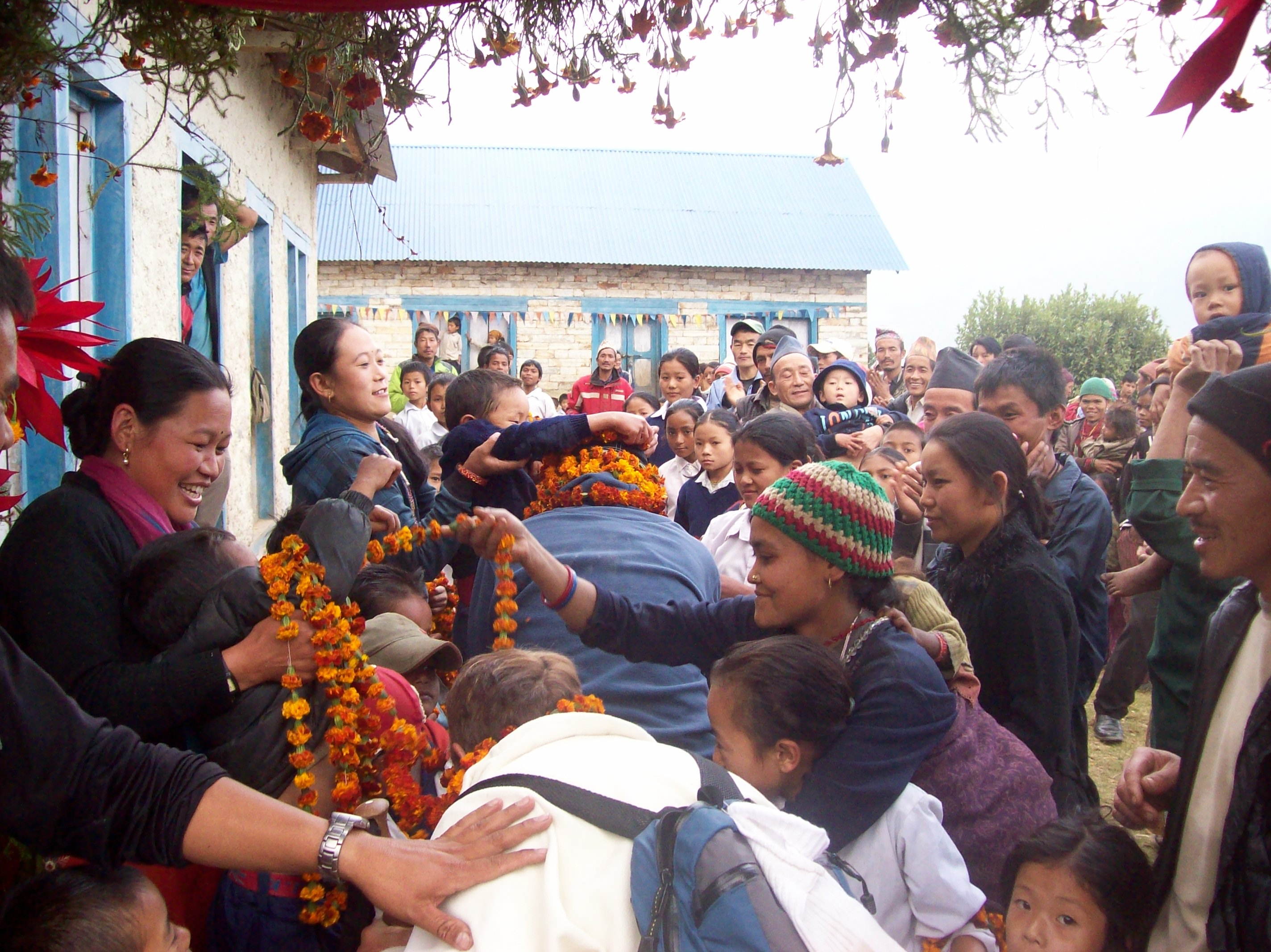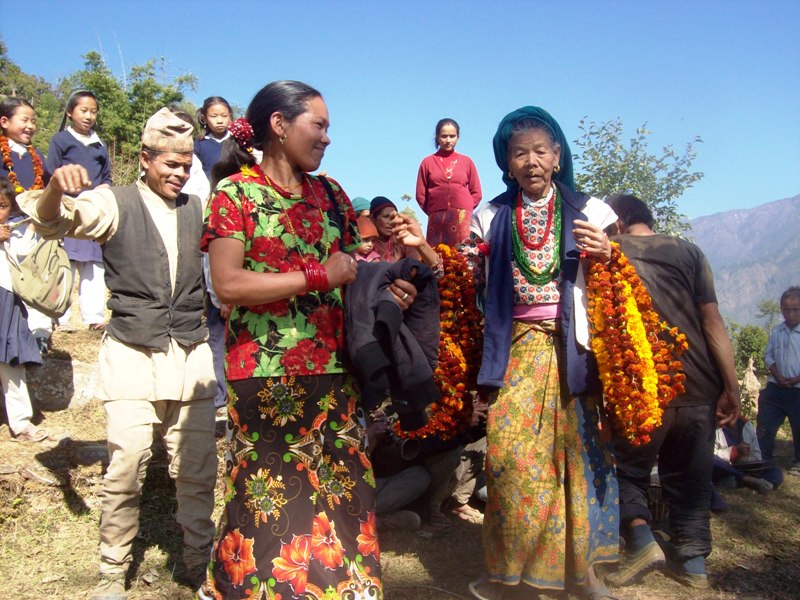PRIOR EXPEDITION FALL 2010, Jiri-Pike Peak-Basa-Phaplu

Mike Miller, Cathy Dawson and I trekked around the Solu region and
to Basa village 6 in Nepal the last half of Nov and early Dec 2010. Our
main purpose was to assist with the initiation of the hydroelectric project
in Basa and provide additional aid to the village school. Mike and I
met with the local project engineer, Chandra Nepali, in the village. We
inspected the waterfall-fed stream, which will serve as the hydro-power
source for the electricity generator. Mike reviewed the plan with Chandra
for construction of a small directional dam and power station and for
stringing wire from the power station to the village. As an electrical
engineer, Mike is satisfied that the plans are sound and he was impressed
with Chandra's practical approach to the difficulties of creating
electricity in such a remote area.
A major concern, however, was that only one generator was delivered
to Basa. We had contracted for two. The problem was resolved, we think, at
a meeting back in Katmandu with representatives of Techno Village Co. (the
supplier of the generator equipment). The explanation we received is that
only one generator was in stock and the second will be available for
transport to Basa within 3 weeks.
The water site is a beautiful waterfall/stream a rigorous 20 minute
hike from the village. The only effects on the environment will be: 1) a
little dam that will help the water flow narrow at a natural funnel to
maximize flow into a pipe during dry season (winter); 2) a cistern and
shelter for the generator; and 3) poles within the village to lift wires up
to the homes. The plan is to pin the wire to a rock wall along the
waterfall and then string wire underground up to the village to minimize the
number of poles needed.
While the equipment is owned by the Basa Village Foundation NGO, the
system will be run and operated by a village co-op. Two village-wide
meetings were held while we were in Basa, and there was great enthusiasm for
the project within the village. A "code of conduct" was agreed to by the
villagers as to the provision of labor by the village to construct and
maintain the system, as well as a sliding scale for villagers to contribute
financially for an initial buy-in and then monthly maintenance of the
system. It is anticipated that construction will be completed within 3 to 6
months. So, I hope when I return to Basa in the fall I will see lights in
the village.
The system will provide very modest electricity to the 62 homes in
the village. Each home will only have enough power for the equivalent of
about 4 low-wattage light bulbs. But the villagers don't have TVs or
high-power appliances. They just want to be able to see around their homes
at night without burning wood or kerosene.
Cathy, Mike and I had a fun and challenging trek to Basa. The high
and low point for me was climbing 14,000 ft. Pike (Peekay) Peak. I scurried
up to the top solo, got lost coming down and had an adventure fighting my
way through heavy underbrush, a rhododendrun and pine forest, and sliding
down a frozen waterfall. I came down the wrong side of the mountain,
because it was covered in a cloud allowing me about 20 feet visibility and I
got disoriented. The trail I was following at the base of Pike was washed
out by an avalanche. As night fall was fast approaching and I was beginning
to look for shelter to survive the night, I found a boot print I recognized
and was able to make it back to camp. Our sirdar and 4 of our crew were
still up on the mtn. looking for me.
Next morning Ganesh, Mike and I hiked back to the top and had
spectacular views of the Everest massif and other 8,000 meter peaks along
the Nepal-Tibet border. Photography was a challenge with 40 mph winds.

As we neared Basa, we were met by the village musicians, who piped
and drummed us into the village. The villagers showered us with flowers,
and matrons pushed cups of rakshi (home-brewed spirits) into our hands.
During our 3 days in Basa we visited many homes as well as the school. The
students performed traditional Rai dances for us.
Cathy's experience as a teacher and massage therapist were put to
good use. While we trekked, she worked daily with 2 of our porter-students
to improve their English. She gave the less shy members of our crew
massages for sore muscles, and delighted the 70-year old wife of the Lama of
Gaur with a first in a lifetime massage. In Basa she taught the kids
rhyming and clap/slap games to aid their English.

We also distributed shoes to all of the guys in our crew and some of their
children courtesy of Carol Donahue's efforts. I delivered some
materials for the school, including bookmarks made by kids in Hamilton Co.
Juvenile Detention under Jill Meisenheimer's directions. And I gave the
student dancers Beanie Babies.
Another favorite memory of the trek is sitting with our crew by a
campfire under the huge starlit sky with white-capped mountains looming
across huge and deep valleys. One night Ganesh and Buddiraj Rai told me
the stories of their Rai forefathers and the unique customs and rites of the
Khaling Rai.
Lastly, I'll forever admire Mike Miller's "slow but sure" approach
to trekking at age 71. He made camp timely everyday and had the energy to
hike up Pike and shoot photos in tearing wind & cold. And he has the
technical knowledge to have helped the local engineer and Basa Village
Foundation NGO to refine the plan for the hydroelectric
system.
Back in Katmandu we enjoyed the quiet of the Nirvana Garden Hotel,
but hung out at the Katmandu Guest House for social life. Friend Uttam,
mgr. of the KGH, introduced us to several other philanthro-trekkers. Over
milk tea and beers we shared ideas about projects in Nepal and travel
adventures. Our own adventure ended with a feast at Niru Rai's house the HQ
of Adventure GeoTreks.
If you are interested in visiting Nepal in 2011 or assisting with
the Basa Project, please contact me at
jrasley@juno.com.
You can access the photo album I have created from the trek via
http://tinyurl.com/24ylnm2
Namaste,
Jeff Rasley

Back to Home page